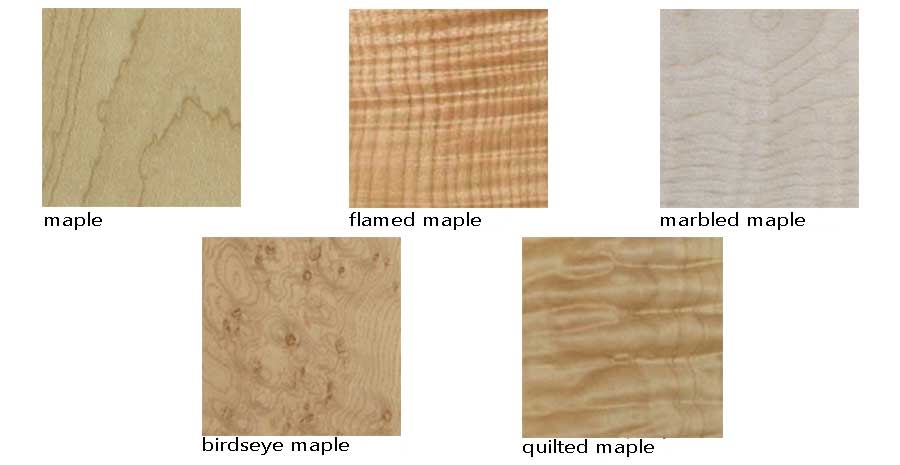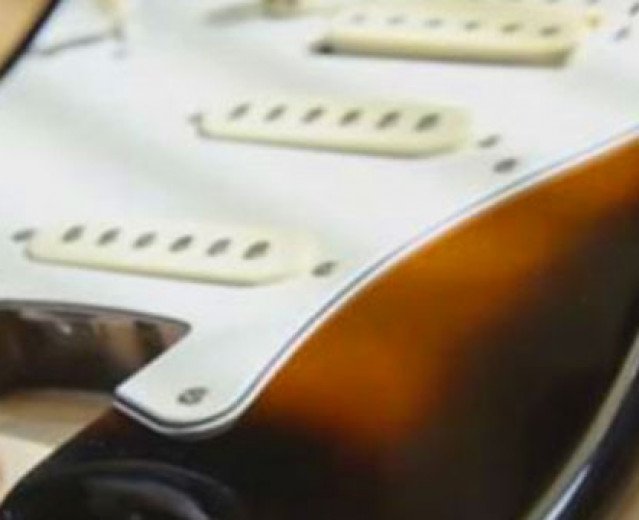Which woods are used and which are their different properties?
Electric guitars and basses are made out of wood, so it is important to
learn how to recognize them and to know about their main esthetical, physical
and sonic characteristics.
In electric instruments, different kind of wood are used for the body,
the neck and for the fretboard (and for finishing). Each one has his own esthetical,
physical and sonic properties, and also the cost can vary depending on the
quality of the single timber lot. Let’s take a look at the different woods
most frequently used in the construction of electric instruments,
summarizing the typical properties of each one.
Maple
Maple is an heavy wood with a compact grain, emphasizing the mid and high
frequencies (similarly to ash and alder, as we will see in a while). With a particularly
light colour and beautiful figure, maple is mainly used for necks and
fretboards, but also for tops or bodies. A maple top, besides being a beautiful
aesthetical addition to the guitar (especially if it is flamed, marbled,
birdseye, quilted, etc..), can positively influence the global tonal openness
of a mahogany body, for instance, putting together a deeper sound and a faster
attack.
- Weight: heavy
- Colour: light
- Grain: diffused and marked figures with valuable variations (flamed, birdseye, etc.…)
- Tone: mid and high frequency emphasised
- Sustain: medium
- Used for: body, fretboard, neck, top

Rosewood
Very dense, heavy and expensive, is used for the fretboards of electric
instruments. Especially beautiful, with noticeable grain and brownish coloured.
Soundwise, combines mid-high frequencies emphasis to a long sustain, thanks to
its peculiar resonance. Many different qualities can be found (from India, Brazil,
Africa, etc..), some of them very valuable.
- Weight: very heavy
- Colour: brown
- Grain: marked figures
- Tone: mid-high frequency emphasised
- Sustain: long
Used for: fretboard
 Indian Rosewood
Indian Rosewood
Ebony
It is a very dense, heavy and compact wood, extremely dark coloured and without
grain, so valuable and expensive that is used only for fretboards and finishing.
Soundwise offers a strong emphasis of the high frequencies of the spectrum, and
feels very hard.
- Weight: very heavy
- Colour: extremely dark
- Grain: no
- Tone: strong emphasis of the high frequencies
- Sustain: very long
- Used for: fretboard, finishing
 Ebony
Ebony
Mahogany
Mahogany is a rather dense wood, with a really fat and warm sound (thanks to
its grain) and a very long sustain. Aesthetically has a typical red colour, sometimes
with valuable figures.
- Weight: relatively heavy
- Colour: reddish
- Grain: not always visible
- Tone: fat and warm with emphasis of the mid-low frequencies
- Sustain: very long
Used for: body, neck
 Mahogany
Mahogany
Alder
This is a light wood, typically light-coloured, with noticeable grains that
make it an ideal choice for transparent or sunburst finish. Sonically is considered one of the most balanced woods,
without emphasis on any frequency band.
- Weight: light
- Colour: usually light
- Grain: noticeable
- Tone: well balanced all over the spectrum
- Sustain: not very long
Used for: body with transparent finish
 Alder
Alder
Ash and swamp ash
The main property of the ash is its specific gravity. Like alder and
maple, its peculiar sound emphasizes the mid-high frequency band. Aesthetically,
ash has a diffuse and well visible grain, suitable for a beautiful transparent finish.
The swamp ash variety, expensive and very well considered, combines a slightly
lighter weight and a very good balance between clearness and warmness of the
sound. Swamp ash is also suitable for a transparent finish, that makes its
beautiful grain pattern stand out.
- Weight: very heavy (ash), relatively heavy (swamp ash)
- Colour: usually light
- Grain: diffuse and very noticeable
- Tone: opened, with the mid-high frequency band emphasized
- Sustain: very long
Used for: body with transparent finish
 Ash
Ash
Basswood
With no visible grain patterns, basswood is frequently used for bodies with
coloured finish. Sonically similar to maple, alder and ash, with more focus on
the mid-band that makes the sound stand out in the mix.
- Weight: medium
- Colour: usually light
- Grain: slightly diffuse and visible
- Tone: warm and opened with mids on the forefront
- Sustain: medium
- Used for: body with coloured finish
Utilizzo in ambito elettrico: corpi con verniciatura coprente
 Basswood
Basswood
There's so much more to say of course, but now you have a nice overwiew on woods used on electric guitars. And by the way, this is the last post on electric guitar world for the moment, you can read the previous articles on our blog.
Enjoy!
